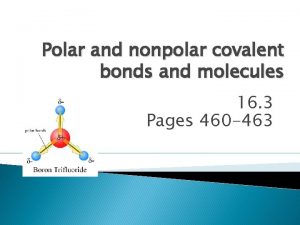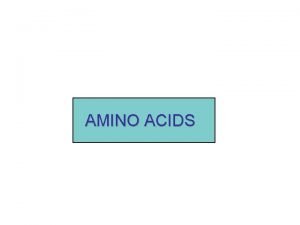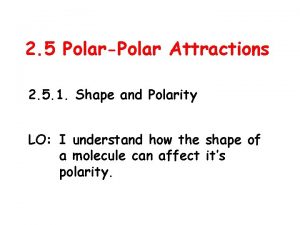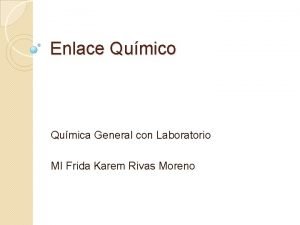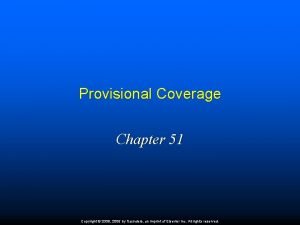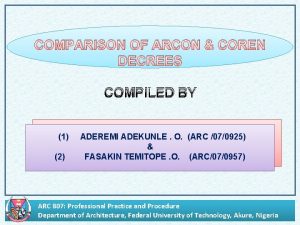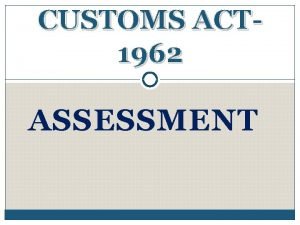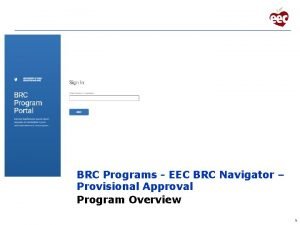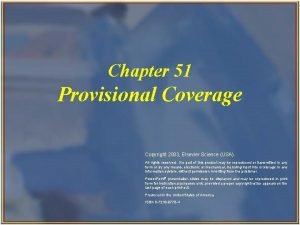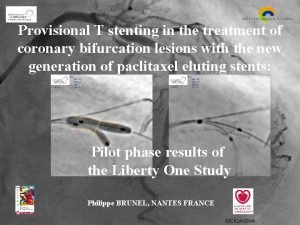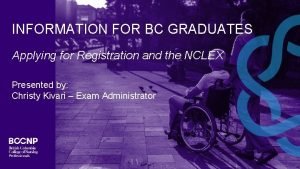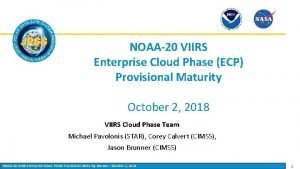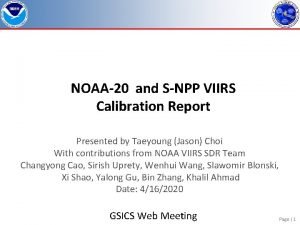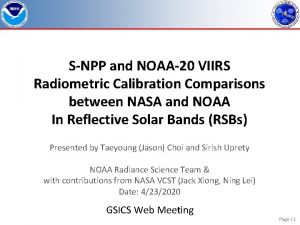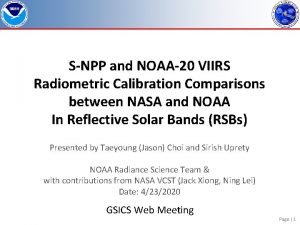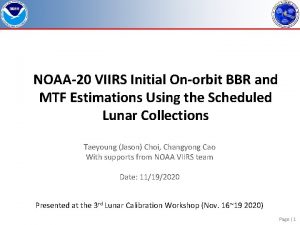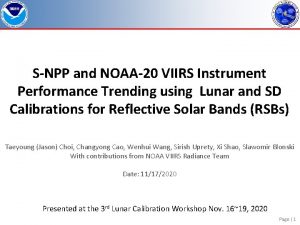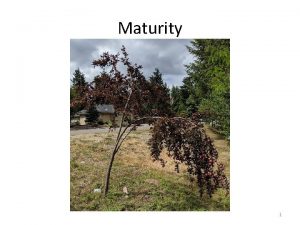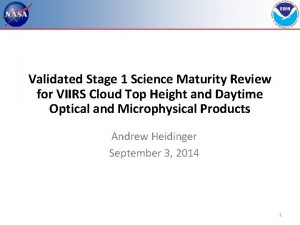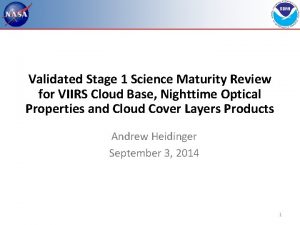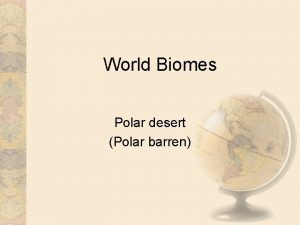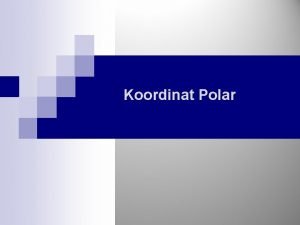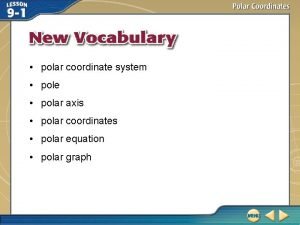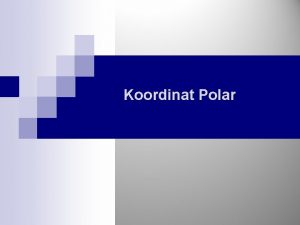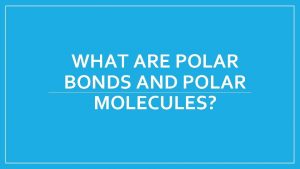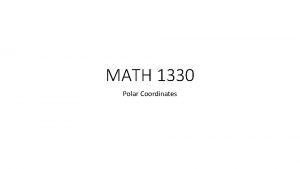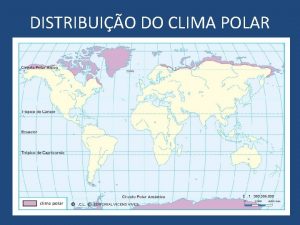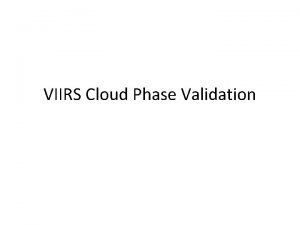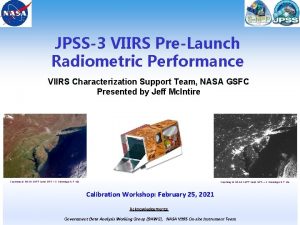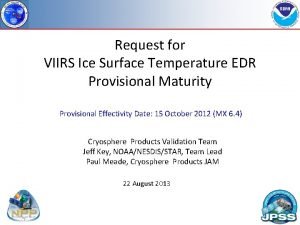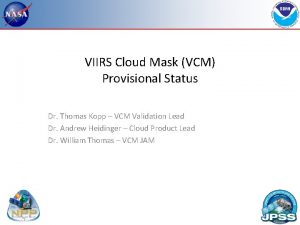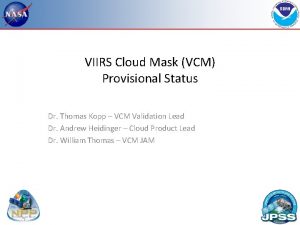Provisional Maturity Science Review For NOAA20 VIIRS Polar























- Slides: 23

Provisional Maturity Science Review For NOAA-20 VIIRS Polar Winds Presented by Jeff Key and Jaime Daniels Date: 2018/10/02

VIIRS Polar Winds (VPW) in Brief VIIRS Polar Winds are derived by tracking clouds features in the VIIRS longwave infrared channel • • • Wind speed, direction, and height are determined throughout the troposphere, poleward of approximately 65 degrees latitude, in cloudy areas only Wind information is generated in both the Arctic and Antarctic regions The algorithm utilizes the Enterprise cloud height, phase, and mask S-NPP VIIRS winds, Arctic NOAA-20 Provisional Calibration/Validation Maturity Review 2

NOAA-20 VIIRS Winds Examples Left: Arctic, 28 Jul 2018, 1942 Z Right: Antarctic, 28 Jul 2018, 2033 Z

Requirements JPSS L 1 RD supplement (threshold) requirements versus observed Attribute Threshold Observed/validated Geographic coverage ~70 o latitude to poles ~65 o to poles Vertical Coverage Surface to tropopause same Vertical Cell Size At cloud tops same Horizontal Cell Size 10 km (should be ~19 km, CCR Aug 2015) same Mapping Uncertainty 0. 4 km (nadir); 1. 5 km (edge 0. 57 km of scan) Measurement Range Speed: 3 to 100 m s‑ 1; Direction: 0 to 360 degrees same Measurement Accuracy Mean vector difference: 7. 5 m/s 5. 7 -7. 0 m/s (w/raobs) Measurement Precision Mean vector difference: 4. 2 m/s (was 3. 8 m/s) 2. 7 -3. 8 m/s (w/raobs) Measurement Uncertainty Not specified Not applicable NOAA-20 Provisional Calibration/Validation Maturity Review 4

AMV Performance Metrics AMVs (QI>60) are matched and compared against RAOBS or GFS model analysis winds. Metrics: where: Ui and Vi ---> AMV Ur and Vr ---> “Truth” NOAA-20 Provisional Calibration/Validation Maturity Review 5

Validation Strategy • Derive winds over both poles using overlapping NPP or NOAA 20 VIIRS orbits • Derive winds with full product precedence in place – Enterprise cloud mask (ECM) product is used – Cloud Products (cloud-top temp, pressure, phase, type) are generated as part of the product precedence chain • Collocate (in space and time) derived satellite winds with reference (“truth”) winds – Radiosonde wind observations (Land) – Aircraft wind observations (Land & Ocean) – GFS analysis winds (Ocean) • Generate comparative statistics (satellite winds minus reference winds) – Accuracy – Precision NOAA-20 Provisional Calibration/Validation Maturity Review 6

7 Derived Motion Winds Test Plan – Offline Validation: Truth Data • Radiosonde wind observations serve as a key validation data source for derived motion wind products • Used by all operational satellite processing centers that generate satellite derived motion winds • Aircraft wind observations • GFS Model Analysis Wind Fields NOAA-20 Provisional Calibration/Validation Maturity Review 7

Validation Statistics NPP VIIRS Winds vs. Radiosondes July 5 -29, 2018 NOAA-20 VIIRS Winds vs. Radiosondes July 5 -29, 2018 Observed Accuracy: 5. 79 -5. 99 m/s Precision: 3. 58 -3. 64 m/s Requirements: Accuracy: 7. 5 m/s Precision: 4. 2 m/s NPP VIIRS winds generated at OSPO NOAA-20 VIIRS winds generated at STAR. Statistics include only VIIRS winds at 12 Z. NOAA-20 VIIRS Winds/Raob co-location files being reprocessed for the month of July to include 00 Z matchups NOAA-20 Provisional Calibration/Validation Maturity Review 8

with GFS Note: SNPP VIIRS winds are currently assimilated in the GFS, so these statistics are only to provide confidence in the quality of the NOAA-20 VPW product. NOAA-20 Provisional Calibration/Validation Maturity Review 9

Quality Indicators ∙ All derived winds are subject to the following quality assurance checks and are flagged if test thresholds are exceeded – Correlation check (threshold = 0. 60) – Correlation match occurs on the boundary of the search scene – u- and v-component acceleration checks (threshold = 10 m/s) – Minimum speed check (threshold >= 3 m/s) – Directional (threshold = 50 deg) and speed checks (threshold = 8 m/s) against forecast ∙ Quality indicators are computed and appended to each derived wind vector – Quality Indicator (QI) – Expected Error (EE) NOAA-20 Provisional Calibration/Validation Maturity Review 10

Quality Indicators, cont. ∙ ∙ QI Component Tests: ∙ AMV Direction Consistency Check ∙ AMV Speed Consistency Check ∙ Vector Consistency Check ∙ Spatial Consistency Check ∙ Test of the spatial wind consistency of the AMV with its closest neighbor. ∙ Forecast Check (Optional) ∙ Comparison of AMV against NWP wind interpolated to AMV location and time. Expected Error (EE) ∙ Originally developed at the Australian Bureau of Meteorology (Le. Marshall et al. , 2004) as an alternative to the QI. ∙ Based on a linear regression of collocated AMV – RAOB vector differences using predictors that include the QI consistency tests and other vector and NWP information ∙ Regression produces an error estimate in m/s rather than a normalized score. NOAA-20 Provisional Calibration/Validation Maturity Review 11

Quality Indicators, cont. ∙ ∙ ∙ Both the QI and EE have their strengths. The EE estimated vector reliability values have a closer 1 -to-1 relationship with actual RMS errors measured against raobs. The QI tends to rank more vectors as reliable, especially fast AMVs. Both methods are used as AMV quality flags. Users can selectively employ the flags in their local quality control. AMVs that pass both EE and QI thresholds are kept. 12 NOAA-20 Provisional Calibration/Validation Maturity Review 12

Exception Handling ∙ ∙ The algorithm checks whether the time interval is valid and that the temporal data has been loaded properly. The algorithm checks that the search region is larger than the target scene. The algorithm checks the sensor data flags to see if channel data is valid. If the AMV retrieval is not performed, the retrieved parameters are set to a missing value and the quality flags are set to the lowest quality value. 13 NOAA-20 Provisional Calibration/Validation Maturity Review 13

Error Budget Attribute Analyzed L 1 RD Threshold On-orbit Performance Meet Requirement? Additional Comments Accuracy 7. 5 m/s 5. 7 -7. 0 m/s Yes Raob, aircraft Precision 4. 2 m/s 2. 7 -3. 8 m/s Yes Raob, aircraft Horizontal cell size 10 km Mapping uncertainty 0. 4 km nadir; 1. 5 km EOS 19 km (inherent Yes to the algorithm) 0. 57 km Yes NOAA-20 Provisional Calibration/Validation Maturity Review MS 2 GT and Mc. IDAS 14

Users 13 NWP centers in 9 countries of polar winds, some using VIIRS winds operationally: • U. S. Users: – NCEP (Dennis Keyser) – NRL/FNMOC (Randy Pauley) – GMAO/JCSDA • Foreign Users: – UK Met Office (Mary Forsythe) – JMA (Masahiro Kazumori) – ECMWF (Jean-Noel Thepaut) – DWD (Alexandar Cress) – Meteo-France (Bruno Lacroix) – CMC (Real Sarrazin) – BOM (John Le. Marshall) – EUMETSAT (Simon Elliott) – Russian Hydrometcenter (Mikhail Tsyrulnikov) – CMA (China) NOAA-20 Provisional Calibration/Validation Maturity Review 15

Users, cont. Courtesy of Naval Research Lab NOAA-20 Provisional Calibration/Validation Maturity Review 16

User Feedback • Over the last decade, model impact studies have demonstrated that model forecasts for the extratropics are improved when the MODIS polar winds are assimilated. Forecasts can be extended 2 -6 hrs, depending on the location. • NWP users have reported similar results for the VIIRS Polar Winds at the recent International Winds Workshops (2016, 2018). From NRL: “The VIIRS ob impact is noteworthy— 20% of the polar wind ob impact from 11% of the polar wind obs. ” Organization Use VPW operationally NCEP Yes (SNPP) DWD Yes Navy Yes ECMWF Yes Met Office CMC Meteo. France Currently monitoring Plan to use? Yes (early 2019 for N 20) Yes Yes Yes Awaiting information from the other NWP centers. NOAA-20 Provisional Calibration/Validation Maturity Review 17

Thank you! NOAA-20 Provisional Calibration/Validation Maturity Review 18

References • Baum, Bryan , P. Yang, Ping; Heymsfield, Andrew J. ; Platnick, Steven; King, Michael D. ; Hu, Y. -X. , and Bedka, Sarah T. , 2005: Bulk scattering properties for the remote sensing of ice clouds, part II: Narrowband models. Journal of Applied Meteorology, Volume 44, Issue 12, pp. 1896 -1911. • Coakley, J. A, and F. P. Bretherton, 1982: Cloud cover from high resolution scanner data: detecting and allowing for partially filled fields of view. J. Geophys. Res. , 87, 4917− 4932. • Dunion, J. and C. Velden, 2002: Application of Surface-Adjusted GOES Low. Level Cloud-Drift Winds in the Environment of Atlantic Tropical Cyclones. Part I: Methodology and Validation. Monthly Weather Review, Volume 130, Issue 5 pp. 1333– 1346 • EUMETSAT, 2005: The EUMETSAT wind vector automatic quality control scheme. EUM/OPS/TEN/05/1747, 10 pp. [Available online at http: //www. eumetsat. int/Home/Main/Publications/Technical_and_Scientific_Doc umentation/Technical_Notes/SP_1124282585834? l=en. • Hamada, T. , 1983: On the optimal time-interval of satellite image acquisition for operational cloud motion wind derivation. Meteorology Center of Japan Meteorological Agency Tech. Note 7, 79– 87. 19 NOAA-20 Provisional Calibration/Validation Maturity Review 19

References • GOES-R Advanced Baseline Imager (ABI) Algorithm Theoretical Basis Document For Derived Motion Winds, Version 2. 0, Sept 30, 2010 • Hansen, M. , R. De. Fries, J. R. G. Townshend, and R. Sohlberg (1998), UMD Global Land Cover Classification, 1 Kilometer, 1. 0, Department of Geography, University of Maryland, College Park, Maryland, 1981 -1994. • Holmlund, Kenneth. The utilization of statistical properties of satellite-derived atmospheric motion vectors to derive quality indicators. Weather and Forecasting, Volume 13, Issue 4, December 1998, pp. 1093 -1104. • Holmlund, Kenneth; Velden, Christopher S. and Rohn, Michael. Enhanced automated quality control applied to high-density satellite-derived winds. Monthly Weather Review, Volume 129, Issue 3, 2001, pp. 517 -529. • Jedlovek, G. and R. Atkinson, 1998: The Marshall automated wind algorithm: Error analysis, quality control and climate applications. Proceedings 3 rd International Winds Workshop, Saanenmoser, Switzerland, pp. 247 -254. • Key, J. , D. Santek, C. S. Velden, N. Bormann, J. -N. Thepaut, L. P. Riishojgaard, Y. Zhu, and W. P. Menzel, 2003, Cloud-drift and Water Vapor Winds in the Polar Regions from MODIS, IEEE Trans. Geosci. Remote Sensing, 41(2), 482 -492. 20 NOAA-20 Provisional Calibration/Validation Maturity Review 20

References • Le. Marshall, J. A. , A. Rea, L. Leslie, R. Seecamp, and M. Dunn, 2004: Error characterization of atmospheric motion vectors. Aust. Meteor. Mag. , 53, 123131 • Menzel, W. P. , 1996: Report from the working group on verification statistics. Proceedings 3 rd International Winds Workshop, Ascona, Switzerland, 10 -12 June 1996, Pages 17 -19. • Merrill, R. T. , 1989: Advances in the automated production of wind estimates from geostationary satellite imagery. Preprints, Fourth Conf. on Satellite Meteorology and Oceanography, San Diego, CA , Amer. Meteor. Soc. , 246− 249. • Merrill, R. T. , W. P. Menzel, W. Baker, J. Lynch, and E. Legg, 1991: A report on the recent demonstration of NOAA’s upgraded capability to derive cloud motion satellite winds. Bull. Amer. Meteor. Soc. , 72, 372– 376. • Minnis P. , P. Heck, D. Young, C. Fairall, and J. Snider, 1992: Stratocumulus cloud properties derived from simultaneous satellite and island-based instrumentation during FIRE. J. Appl. Meteor. , 317 -339. • Nieman, S. J. , J. Schmetz, and W. P. Menzel, 1993: A comparison of several techniques to assign heights to cloud tracers. J. Appl. Meteor. , 32, 1559− 1568. 21 NOAA-20 Provisional Calibration/Validation Maturity Review 21

References • Otkin, J. A. , D. J. Posselt, E. R. Olson, H. -L. Huang, J. E. Davies, J. Li, and C. S. Velden, 2007. Mesoscale numerical weather prediction models used in support of infrared hyperspectral measurements simulation and product algorithm development. J. Atmospheric and Oceanic Tech. , 24, 585 -601. • Ottenbacher, A. , M. Tomassini, K. Holmlund, and J. Schmetz, 1997: Low-Level Cloud Motion Winds from Meteosat High-Resolution Visible Imagery. Weather and Forecasting Volume 12, Issue 1, pp. 175– 184 • Rossow, W. B. , F. Mosher, E. Kinsella, A. Arking, M. De. Bois, E. Harrison, P. Minnis, E. Ruprecht, G. Seze, C. Simmer, and E. Smith, 1985: ISCCP cloud algorithm intercomparison. J. Climate Appl. Meteor. , 24, 877− 903. • Schmit, T. , Gunshor, M. , Menzel, W. , Gurka, J. , Li, J. , and Bachmeier, A. , (2005) Introducing the next-generation advanced baseline imager on GOES-R. Bull. Amer. Meteor. Soc. , Volume 86, Issue 8, pp 1079 -1096. • Shenk, W. E. , 1991: Suggestions for improving the derivation of winds from geosynchronous satellites. Global Planet. Change, 4, 165– 171. 22 NOAA-20 Provisional Calibration/Validation Maturity Review 22

References • Velden, C. S. , and K. M. Bedka, 2008: Identifying the Uncertainty in Determining Satellite-Derived Atmospheric Motion Vector Height Assignments. Conditionally accepted in J. Appl. Meteor. • Velden, C. , J. Daniels, D. Stettner, D. Santek, J. Key, J. Dunion, K. Holmlund, G. Dengel, W. Bresky, W. P. Menzel, 2005: Recent innovations in deriving tropospheric winds from meteorological satellites. Bull. Amer. Meteor. Soc. , 86, 205 -221. • Velden, C. , D. Stettner, and J. Daniels, 2000: Wind vector fields derived from GOES rapid-scan imagery. Proc. 10 th Conf. on Satellite Meteor. and Oceanography. , Long Beach California, Amer. Meteor. Soc. , 20– 23. 23 NOAA-20 Provisional Calibration/Validation Maturity Review 23
 Maturity indices of vegetables
Maturity indices of vegetables Hydrogen or covalent bond stronger
Hydrogen or covalent bond stronger Sustancia polar y no polar
Sustancia polar y no polar Why is lysine basic
Why is lysine basic Polar polar attractions
Polar polar attractions What are polar and nonpolar dielectrics
What are polar and nonpolar dielectrics Enlace covalente coordinado
Enlace covalente coordinado Science is my favorite subject because
Science is my favorite subject because Types of provisional coverage
Types of provisional coverage Din no means
Din no means Arcon provisional registration
Arcon provisional registration Finalisation of provisional assessment under customs
Finalisation of provisional assessment under customs Eec lead portal
Eec lead portal Preformed polymer crowns
Preformed polymer crowns Inverted provisional stenting
Inverted provisional stenting Nurse verification bccnp
Nurse verification bccnp Fspos vägledning för kontinuitetshantering
Fspos vägledning för kontinuitetshantering Typiska drag för en novell
Typiska drag för en novell Tack för att ni lyssnade bild
Tack för att ni lyssnade bild Ekologiskt fotavtryck
Ekologiskt fotavtryck Shingelfrisyren
Shingelfrisyren En lathund för arbete med kontinuitetshantering
En lathund för arbete med kontinuitetshantering Särskild löneskatt för pensionskostnader
Särskild löneskatt för pensionskostnader Tidbok yrkesförare
Tidbok yrkesförare

